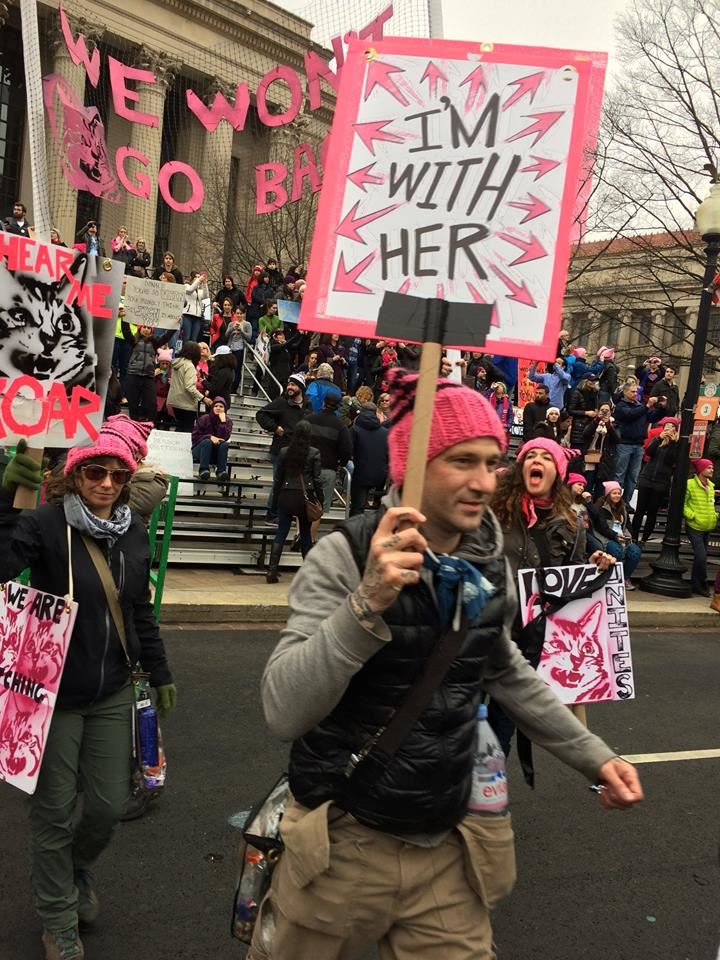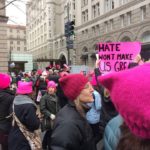Women’s March on Washington: An Exercise in First Amendment

By Gail Kent, Past President
Even though I came of age during the Vietnam War, the Women’s March on Washington was my first protest march. There always was a reason standing between me and political protesting. My parents. My first husband’s military career. My current husband’s security clearance.
But with my husband’s retirement and my increasing concern about the direction our country is taking with the new administration, even my husband’s angst about my safety could not keep me home this time. I was elated when my granddaughter Cheyenne, who turned 17 the day before, asked to join my friend Pat Harvey and I on the train from Newport News to D.C.
 As we crossed the Potomac and glided into the city around 12:30 p.m. on Jan. 21, we saw oceans of pink hats, named after the slang word for the body part candidate Trump’s now-infamous remarks made de rigueur on cable news and social media. I knitted about 25 of the hats and sold them for a personal fundraising project to benefit the Women’s March, which cost about $2 million for communication, security, clean-up and portable restrooms.
As we crossed the Potomac and glided into the city around 12:30 p.m. on Jan. 21, we saw oceans of pink hats, named after the slang word for the body part candidate Trump’s now-infamous remarks made de rigueur on cable news and social media. I knitted about 25 of the hats and sold them for a personal fundraising project to benefit the Women’s March, which cost about $2 million for communication, security, clean-up and portable restrooms.
From Union Station, we were only a block from the action. But we were too late and too far back in the throngs of people to hear any of the speakers, nor any of the directions about how and where to march. The crowd estimates vary from 500,000 to 1.2 million, but they dwarfed the expected 200,000 people the planners had prepared for.
The sheer numbers made marching nearly impossible, as droves of confused people migrated east, then west, like off-course flocks of blackbirds, but all in good humor and with uncommon patience and politeness toward each other, volunteers and Capital Police. One police officer was overheard saying, “They’re all so nice, I don’t know what I’m supposed be doing.” There were only four reported police calls during the march, all for injuries or illnesses. Videos show protesters high-fiving, thanking and hugging police officers. I was thankful there was no violence as there was the night before.
We didn’t so much “march,” as shuffle — and chant. Someone in the crowd would start a chant, such as, “What does democracy look like?” and we would reply, “This is what democracy looks like!” We were shoulder to shoulder, 30 to 40 people deep, all the way down Constitution and Pennsylvania avenues, past the old post office that is now Trump International Hotel. We marched to the 1300 block of Pennsylvania, where barriers block access to the White House.
Grandstands that were set up for the inaugural parade route the day before were filled with protesters. An Ohio delegation of several hundred held up a banner proudly declaring their state affiliation. There were men wearing women’s bras over their T-shirts and holding signs declaring, “I’m With Her,” with arrows pointing in all directions. There were 90- and 100-year-old women in wheelchairs. There were 3- and 4-year-old children in tow, and many families.
While signs in support of women’s rights were a common theme during the march, immigration, healthcare, education and Trump/Pence, in general, were also themes. The signs were creative and funny. Here are just a few:
- You Can’t Comb Over Misogyny
- Meryl Streep is Not Overrated
- Men in Tights for Women’s Rights
- We are the Granddaughters of the Witches You Couldn’t Burn
- The Rise of Women Does Not Mean the Fall of Men
I came away from my first protest with a renewed appreciation for the First Amendment. Our right to peaceably assemble and express our political views, regardless of which side of the political divide we fall on, is a precious right that must never be taken for granted.

